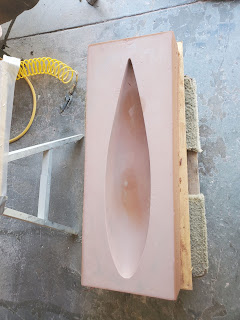Long Time, No Blog
Another case of weird perception. I haven't posted a blog in a long time because I didn't feel like I was making enough progress to write about. Looking back, however, is showing me that I've been making good progress. It's hard to see on a day to day basis, but over a longer period of time, it's actually been moving. As a result, this will be a longer catch-up post, and I'll try to be better in the future and post roughly weekly.
Then it was time for the long, tedious process of putting in epoxy fillets and cleaning them up by sanding. The fillets are thickened epoxy, applied with popcicle sticks and/or tongue depressors. It's a messy process, and takes some practice to avoid spending your life removing excess epoxy. Once the epoxy kicks, the fillets need to be cleaned up. To some extent, they can be sanded with a cartridge roll, which is a piece of rolled up sandpaper with a hole in the middle. The roll is assembled onto a mandrel in a die grinder, and you can sand radii with them. Those familiar with porting heads and polishing injection forming dies are intimately familiar with them. The fillets are still mostly sanded by hand, though.
In late March, I started connecting ring frames with stringers. This is a fairly long and involved process. The pockets were cut by a CNC router, which means they're basically in a "maximum material condition". The pockets are in the correct position, but material needs to be removed to allow the stringers to be installed and twisted to the curve and angles that the hull will eventually take. I used an electric die grinder from Harbor Freight with wood burrs. They look like a Surform (surfboard shapers know these) on a cylinder. They remove material a little quicker than standard metal burrs. I worked from the stern to the bow, one stringer on a side at a time. I shaped one pocket on one side of the transom, then the corresponding pocket on the other. I then screwed in the stringer, and worked forward and side to side until the stringer was finished. Remove the screws, pack the pockets with thickened epoxy, and reassemble the stringer. Same on the other side. Rinse and repeat for the remaining stringers. This whole process took me about a week and a half.
Once the stringers are in, the stringers and the ring frames need to shaped. This is to allow the plywood to be curved during assembly and so it sits flat against the stringers to get a good epoxy joint/bond. The bonds between ring frames and plywood, and the stringers and plywood are where the boat gets most of its strength.
Shaping stringers and ring frames is done with electric hand planers (like you'd use on a door in your house) and belt sanders. The hand planer works great but is kind of unforgiving. If you run it in slightly the wrong direction over one of the corner reinforcements (plywood), it blows one side out of the plywood, making a big fix it project. I did it a couple of times, and I'm very sad. The shaping involves taking a couple of cuts with the planer and/or sanding with the belt sander for a while, and then using a straightedge to judge your work. It also involves using a somewhat slightly trained eye to attempt to glean whether the boat is symmetrical while shaping. Some measurement can be done, but one could drive themselves absolutely bonkers trying to measure and shape it perfectly. Since I was mostly there to start with, it didn't take much to make me certifiable. Again.









Comments
Post a Comment